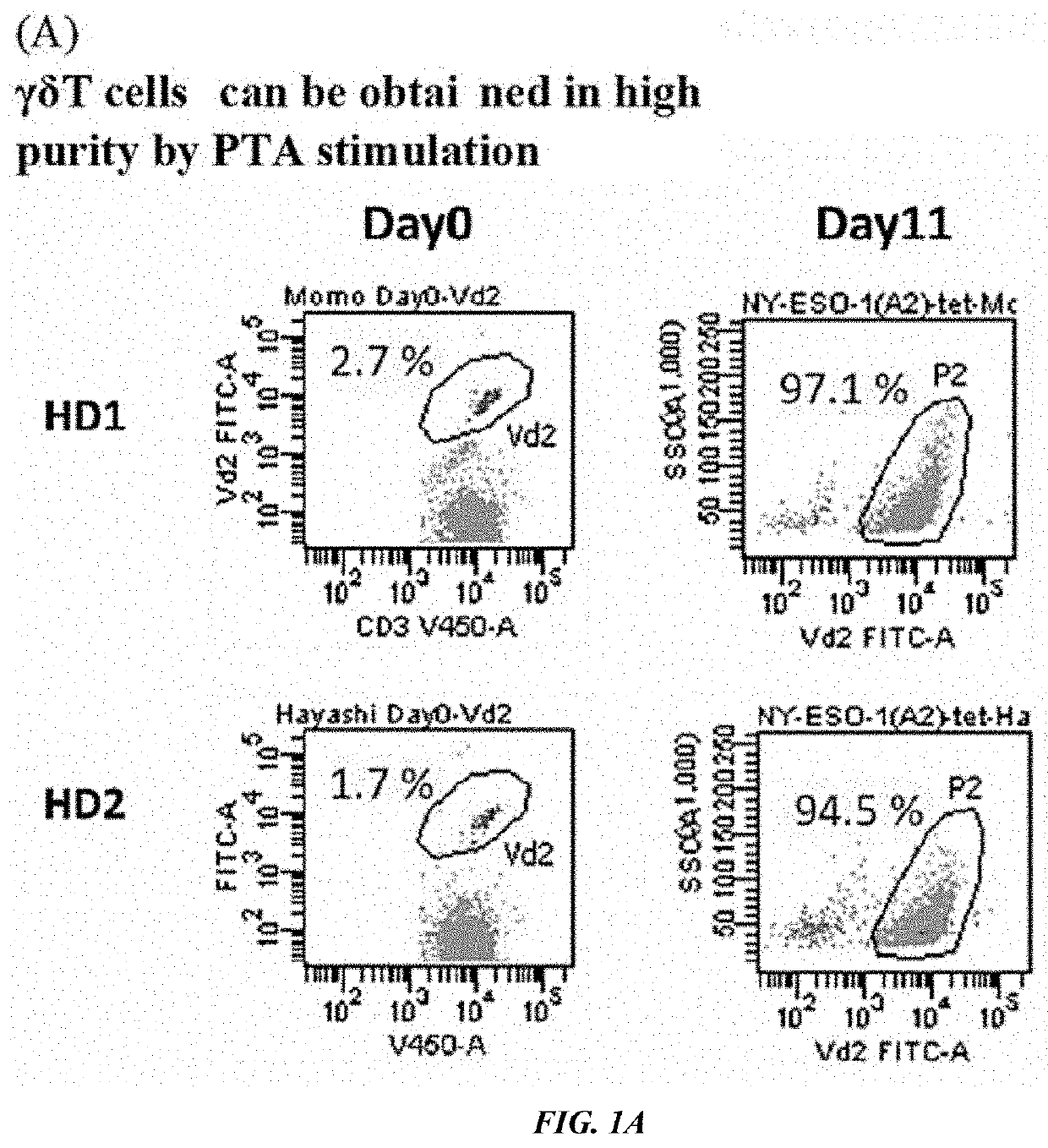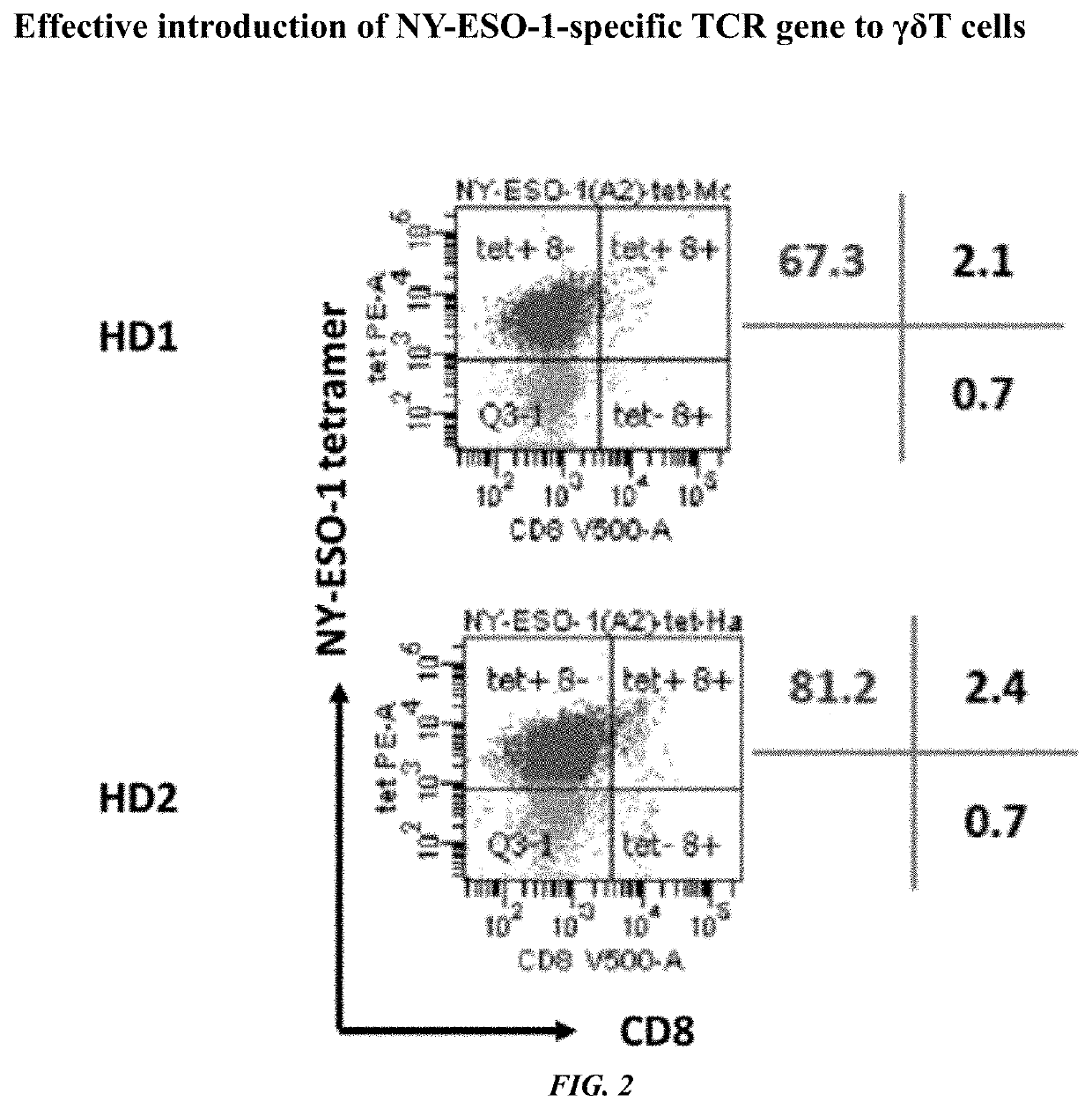Method for gene transfer into gamma-delta type t cell
a technology gene transfer methods, which is applied in the direction of genetically modified cells, drug compositions, peptides, etc., can solve the problems of low purity of gamma-delta type t cells obtained by expanded culture, difficult to secure the number of cells required for cell analysis, and insufficient analysis of cytological characteristics such as the cell function of t cells, so as to reduce the burden on subjects requiring blood collection
- Summary
- Abstract
- Description
- Claims
- Application Information
AI Technical Summary
Benefits of technology
Problems solved by technology
Method used
Image
Examples
example 1
[0090][Proliferation of γδT Cells]
[0091]The monocytes were prepared from peripheral blood of two healthy subjects by Ficoll. Personal agreement for the blood collection was achieved based on the research ethics code of the medical school of Mie University. The monocytes adjusted to 1.5×106 cells / mL with the culture solution of Yssel containing 10% human AB serum were cultured for one day in the presence of tetrakispivaloyloxymethyl 2-(thiazole-2-ylamino) ethylidene-1,1-bisphosphonate (compound 7, 1 μM), and then added with 25 ng / mL of IL-7 (Miltenyi Biotec, catalog number: 170-076-111) and 25 ng / mL of IL-15 (Miltenyi Biotec, catalog number: 170-076-114), and further cultured for 10 days. The frequency of the γδT cells in the monocyte population were analyzed by flow cytometry (FACSCANTO II, Becton Dickinson). As a result, the ratio of the γδT cells at the start of culture (Day 0) was 2.7% for donor 1 (HD1) and 1.7% for donor 2 (HD2), respectively. By culturing in the presence of com...
example 2
[0094][Production of a γδT Cell Population Introduced with a Foreign Gene (TCR)]
[0095]On Day 0, 1.5×106 monocytes collected from 1.5 mL of peripheral blood of healthy human were stimulated and cultured in the presence of compound of 7 (1 μM). On Day 1, IL-7 and IL-15 were added to the culture solution to make the final concentration of 25 ng / mL, respectively. On Day 4 and Day 5, infection introduction was performed by using a retroviral vector for NY-ESO-1-specific TCR expression which specifically recognizes a complex of HLA-A2 and NY-ESO-1p157-165 peptide (SLLMWITQC) in the presence of Retronectin® (Takara Bio Inc.). Thereafter, the culture was continued by a culture solution containing IL-7 and IL-15. On Day 11, the expression efficiency of the introduced TCR was examined. The results are shown in FIG. 2. It is shown by FIG. 2 that γδT cells introduced with a TCR gene was obtained with high efficiency. The obtained γδT cells were positive for CD3 which forms a complex with TCR an...
example 3
[0097][Recognition of an Antigen-Specific Tumor Cell Line by γδT Cells Introduced with a TCR Gene]
[0098]Tumor recognition of γδT cells introduced with TCR genes which recognize NY-ESO-1p157-165 peptide specifically in the restriction of HLA-A*02:01 was examined. The results are shown in FIG. 4. The production of IFN-γ was confirmed by intracellular cytokine staining using intracellular IFN-γ staining method when SK-MEL-37 cell line which is NY-ESO-1 positive HLA-A*02:01 positive cell line and the γδT cells were co-cultured (4 hours). However, no production of IFN-γ was observed in the co-culture with Mel 72 which is NY-ESO-1 negative HLA-A*02:01 positive cell line. As positive control, an HLA-A2 positive T2 cell line (T2-ESO1) added with NY-ESO-1p157-165 peptide was used. While as negative control, a T2 cell line (T2-MAGE) added with MAGE-A4p230-239 peptide was used. It was shown that the TCR-introduced γδT cells produced were functional and recognized tumor cells antigen-specifical...
PUM
| Property | Measurement | Unit |
|---|---|---|
| concentration | aaaaa | aaaaa |
| concentration | aaaaa | aaaaa |
| half-volume | aaaaa | aaaaa |
Abstract
Description
Claims
Application Information
 Login to View More
Login to View More - R&D
- Intellectual Property
- Life Sciences
- Materials
- Tech Scout
- Unparalleled Data Quality
- Higher Quality Content
- 60% Fewer Hallucinations
Browse by: Latest US Patents, China's latest patents, Technical Efficacy Thesaurus, Application Domain, Technology Topic, Popular Technical Reports.
© 2025 PatSnap. All rights reserved.Legal|Privacy policy|Modern Slavery Act Transparency Statement|Sitemap|About US| Contact US: help@patsnap.com



